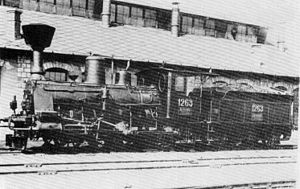EMGV 27-29
| EMGV 27–29 MÁV IIp / MÁV series 241 |
|
|---|---|
|
MÁV IIp 1263
|
|
| Numbering: | EMGV 27–29 MÁV 1002–1004 MÁV IIp 1261–1263 MÁV 241,001–003 |
| Number: | EMGV: 3 MÁV: 3 (from EMGV) |
| Manufacturer: | Budapest |
| Year of construction (s): | 1886 |
| Axis formula : | 1B n2 |
| Gauge : | 1435 mm ( standard gauge ) |
| Length over buffers: | 14,900 mm |
| Length: | 8,324 mm |
| Height: | 4,570 mm |
| Width: | 3,060 mm |
| Total wheelbase: | 4,300 mm |
| Empty mass: | 33.8 t |
| Service mass: | 38.43 t |
| Friction mass: | 25.43 t |
| Top speed: | 70 km / h |
| Driving wheel diameter: | 1,600 mm |
| Impeller diameter: | 1,200 mm |
| Number of cylinders: | 2 |
| Cylinder diameter: | 420 mm |
| Piston stroke: | 630 mm |
| Boiler overpressure: | 12 atü |
| Number of heating pipes: | 166 |
| Heating pipe length: | 3,900 mm |
| Grate area: | 1.9 m² |
| Radiant heating surface: | 8.5 m² |
| Tubular heating surface: | 91.5 m² |
| Evaporation heating surface: | 100 m² |
The EMGV 27-29 were passenger train - tender locomotives of the First Hungarian-Galician Railway (Első Magyar Gácsországi Vasút, EMGV).
The three machines were built by Budapest in 1886 .
In the course of nationalization, the Hungarian State Railways (MÁV) initially gave them the numbers 1002–1004, and from 1891 in the second designation scheme the category IIp with the numbers 1261–1263. From 1911 onwards they were referred to as 241.001–003.
After 1918 the three locomotives came to the SHS in Yugoslavia and were taken out of service in the 1920s.
literature
- Machine factory of the Royal Hungarian State Railways . (ca.1906).
- Mihály Kubinszky (ed.): Hungarian locomotives and railcars . Akadémiai Kiadó, Budapest 1975, ISBN 963-05-0125-2 .
- Ernő Lányi et al .: Nagyvasúti Vontatójárművek Magyarországon . Ed .: Közlekedési Múzeum. Közlekedési Dokumentációs Vállalat, Budapest 1985, ISBN 963-552-161-8 .
